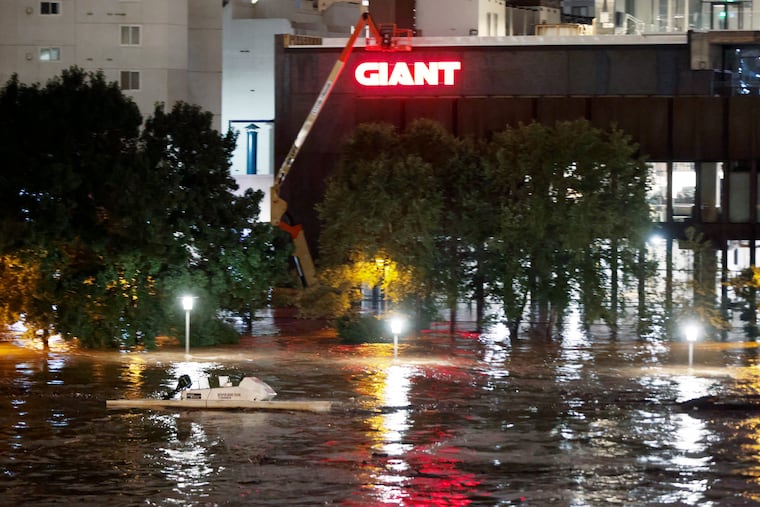Pa. releases climate action plan to lower greenhouse gas emissions
The Pennsylvania Climate Action Plan for 2021 lays out 18 ways to reduce greenhouse emissions by one-quarter by 2025 and 80 percent by 2050.

The Wolf administration on Wednesday issued a climate plan for 2021 that notes the state’s average temperature has risen nearly 2 degrees since 1900 — most of it in the last 20 years — and that the future is likely to feature more warmth, flooding and extreme weather unless greenhouse gas emissions are lowered.
At a news conference, Patrick McDonnell, commissioner of the state Department of Environmental Protection, cited the remnants of Hurricane Ida as an example that warmth is “increasing the intensity of weather events from this month’s historic flooding and tornadoes in southeastern counties. ... We need to significantly lower greenhouse gas emissions to prevent the worse impacts and adapt to the level of impact we are already experiencing.”
He said average temperatures could rise 5.9 degrees by mid-century over an average temperature from the baseline of 1970 to 2000.
The climate plan contains 18 recommendations to help achieve Wolf’s goals of reducing greenhouse gas emissions by 26% by 2025, and 80% by 2050, compared with 2005 levels.
Yassmin Gramian the state’s secretary of transportation, said 400 roads, including 16 major interstates or expressways, were shut down due to Ida. Philadelphia’s Vine Street Expressway, she said, filled with 30 million gallons of water “as if a river was flowing through the city.” More than 800 bridges need post-flood inspections.
The report says infrastructure such as roads, bridges and stormwater systems are all likely to be impacted by flooding related to sea level rise, tropical cyclones, or other heavy precipitation. Philadelphia, the report notes, is intersected by major waterways that could see more flooding, such as the Schuylkill and Delaware Rivers, and Cobbs, Darby and Wissahickon Creeks. Ida in 2021 and Isaias in 2020 illustrate the potential peril.
Allison Acevedo, the DEP’s director of environmental justice, said lower-income neighborhoods pose particular challenges because they have older housing and limited access to air conditioning, even as temperatures more often soar into the 90s.
The plan notes how increased heat will impact cities such as Philadelphia, where some neighborhoods can be up to 20 degrees warmer than others because of a lack of trees, and lots of asphalt and concrete.
The results of warming will lead to an expected average 8% increase in rain and cause more statewide inland flooding, including in the Delaware Estuary coastal zone, around Philadelphia, the plan states.
Among the recommendations for the next five years are updated building codes that focus on energy efficiency, and overall improvements in efficiency for commercial, residential and industrial buildings. More solar energy and incentives for farms to increase efficiency are also noted.
Goals over the next 10 years include more fuel-efficient vehicles, and less use of single-occupancy vehicles and more light-duty electric vehicles. Also making the list were instituting a low-carbon fuel standard, and increasing capture of methane from non-fossil sources including animal manure, food waste, and landfill gas.
The plan also seeks to reduce methane emissions from oil and natural gas operations, provide training in agricultural best practices, and use forest management to increase carbon absorption.
Beyond 10 years, the plan recommends reaching an agreement with other states to sell only zero emission vehicles by 2050, and establish a grid free of carbon emission.
Wolf already has plans to join 11 Northeast states, including New Jersey and Delaware, in the Regional Greenhouse Gas Initiative. That plan seeks to reduce carbon dioxide emissions from electric power plants through a “cap-and invest” policy tool that aims to reduce carbon dioxide emissions from electric power plants through a market-based approach. The administration has submitted its plan to the state’s Independent Regulatory Review Commission for review.
Patrick Henderson, a member of the state’s Climate Change Advisory Committee, took issue with the new climate report.
In a statement, he called climate change “the McCarthyism of our time,” and disagreed with some of the plan’s conclusions and recommendations, saying it also fails to recognize a correlation between the decline of carbon dioxide emissions in Pennsylvania and the rise of natural gas for electricity generation.
He works for the Marcellus Shale Coalition, a natural gas trade group, and noted that his views were not reflective of the coalition.
The report does reflect that emissions are expected to decrease or level off by 2050 even if nothing is done, and officials say that is because of the switch away from coal-fired plants to natural gas.
Henderson wrote the plan’s “fatal flaw” is that none of the proposals would lead to decreased greenhouse gas emissions in other states and, therefore, can’t really bring about a net reduction in emissions.
McDonnell, the DEP commissioner, countered that Pennsylvania is one of the top five greenhouse gas emitters in the U.S., so its actions will lead to net reductions.